Pad Woon Sen is a Thai glass noodle stir fry that is quick and easy to make at home in under 40 minutes!
This Thai Pad Woon Sen recipe belongs in your Asian repertoire because it’s downright delicious, easy, customizable, and can be on your table quicker than driving to your favorite restaurant! This recipe is a soft tangle of chewy glass noodles, chicken (or sub your favorite protein), and veggies, enveloped in a savory, slightly-sweet stir fry sauce. Today, I’m going to teach you how to make these Thai noodles at home with step-by-step photos, tips and tricks and a pantry friendly sauce. Serve your Pad Woon Sen with Tom Kha Gai to complete the feast!
It’s no secret that Thai food is my favorite cuisine to eat and to make! If you’re a fan of Thai food, you’ll love my Pad Thai, Panang Curry, Thai Basil Chicken, Red Curry, and Thai Basil Chicken.
How to Make Pad Woon Sen Video
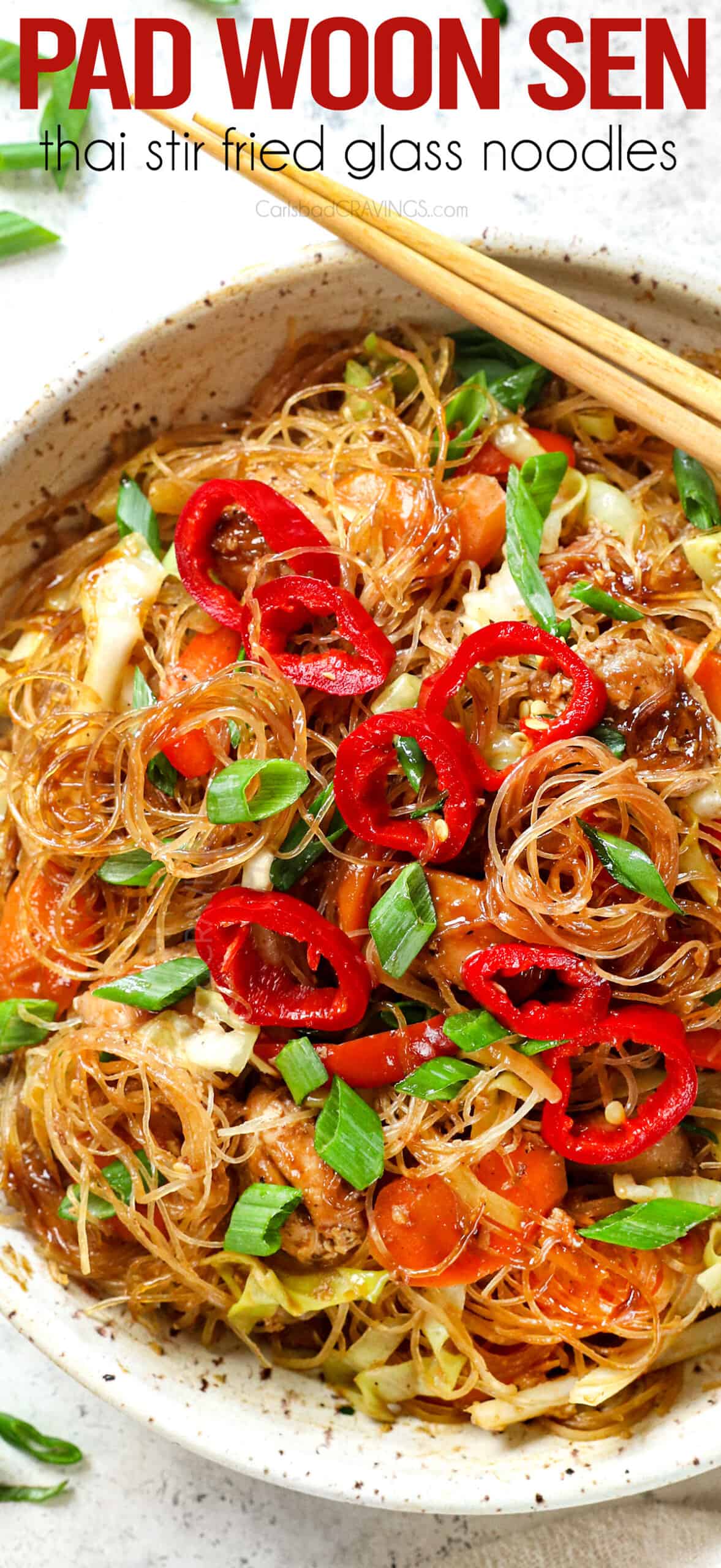

WHY YOU’LL LOVE Pad Woon Sen Recipe
The sauce is to live for. This sauce is downright swoon worthy and makes the dish with complex multi-dimension flavors. The soy and oyster sauce bring the savory depth, fish sauce injects the umami richness, rice vinegar and sugar add the sweet tart notes and red pepper flakes and white pepper add a subtle heat.
This recipe is made without any exotic ingredients. Authentic Pad Woon Sen is typically made with Thai sweet soy sauce and dark soy sauce, along with oyster sauce, vinegar and sugar. I’ve simplified the recipe to create a sauce that’s absolutely hypnotic but pantry friendly, so you still can make this recipe any night of the week.
You don’t need a wok. This recipe can also be made with a nonstick skillet!
The recipe is customizable. This Thai noodle dish can be made with any protein you wish instead of chicken such as ground pork, shrimp or even tofu and any veggies you heart desires or your fridge necessitates.
It’s surprisingly quick and easy. As with all stir fries, most of the recipe making is in the prep. Once you have chopped your veggies and whisked together your sauce, it’s less than 15-minute of actual cook time all in ONE PAN!

what is pad woon sen?
Pad Woon Sen (pad (ผัด) – means fried and woon sen (วุ้นเส้น) – means vermicelli) is a a lesser known Thai stir fry noodle dish made with thin glass noodles, fresh vegetables, eggs, and your choice of protein (chicken, ground pork and shrimp are all popular). But what truly sets this dish apart is the wonderfully chewy texture of the glass noodles. The noodles are doused in a mild, slightly sweet, slightly tangy sauce made with oyster sauce, soy sauce, fish sauce, rice vinegar and sugar. It’s a swoon worthy combination that will leave you wanting more – and grateful you can whip up another batch in just over 40 minutes!

What are glass noodles?
Glass noodles, also known as cellophane noodles, mung bean, or bean thread noodles, give Pad Woon Sen its quintessential chewiness. Glass noodles are traditionally made from mung bean starch and another starch, often potato starch or pea starch, and become as clear as glass once cooked! To cook, simply soak them in a bowl of hot water for about 10 minutes.
When shopping, look for bright white, very thin noodles with mung bean starch listed in the ingredients and not rice (which makes rice vermicelli noodles), and not sweet potatoes (which makes Korean glass noodles). These other noodles don’t become clear after they’re soaked and aren’t as chewy, and therefore won’t deliver the expected and sought after texture.
If you can’t find glass noodles at your local Asian market, you can purchase them on Amazon HERE.

Recipe Ingredients
This Pad Woon Sen recipe is made with pantry friendly ingredients if you do much Asian cooking, otherwise, you can find the ingredients at your grocery store. The glass noodles are the only exception, which can be found at an Asian market or Amazon. Here’s what you’ll need to make these Thai noodles (full recipe in the printable recipe card at the bottom of the post):
For the Chicken:
For the Stir-Fry:
For the Pad Woon Sen Sauce:
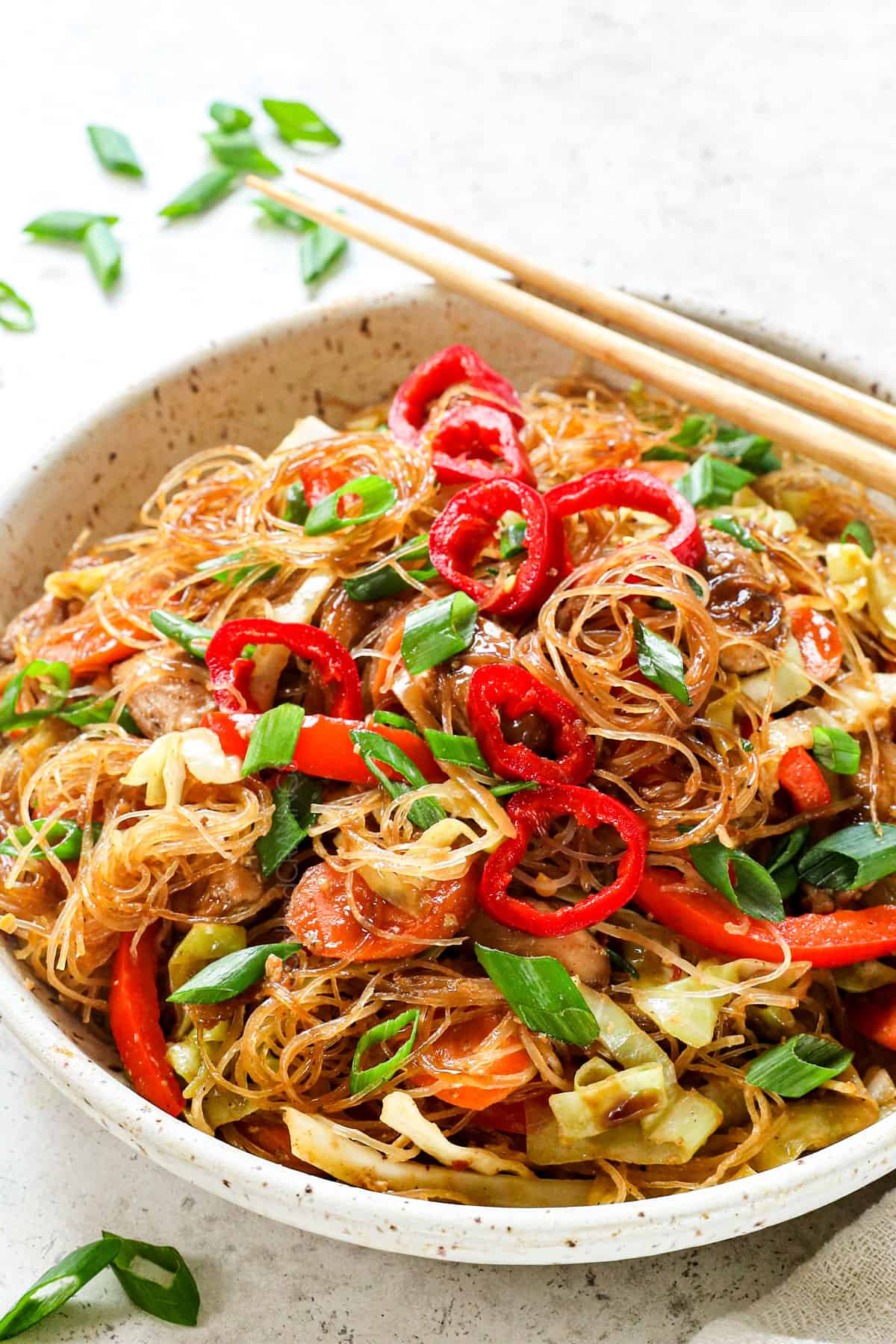

WHAT IF I’M ALLERGIC TO SHELLFISH?
If you’re allergic to shellfish or vegetarian, use LEE KUM KEE Vegetarian Stir-Fry Sauce instead of oyster sauce. You may also use soy sauce in a bind – just don’t expect as spectacular of results
HOW TO MAKE Pad WooN Sen
Thai Pad Woon Sen is a straightforward glass noodle stir-fry that anyone can make. The sauce is a simple whisk-together recipe, and the chicken and veggies are cooked in mere minutes in a hot wok or skillet. Let’s review the basics of how this recipe is made (full recipe in the printable recipe card at the bottom of the post):


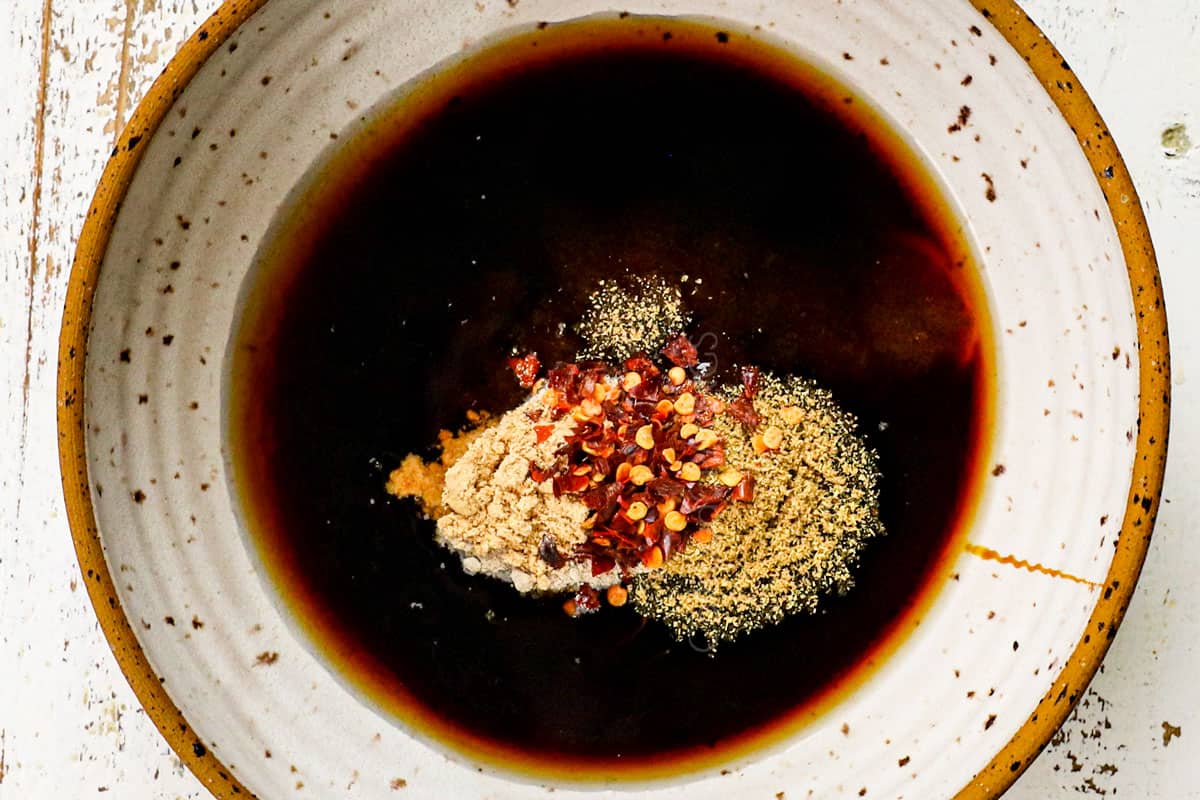
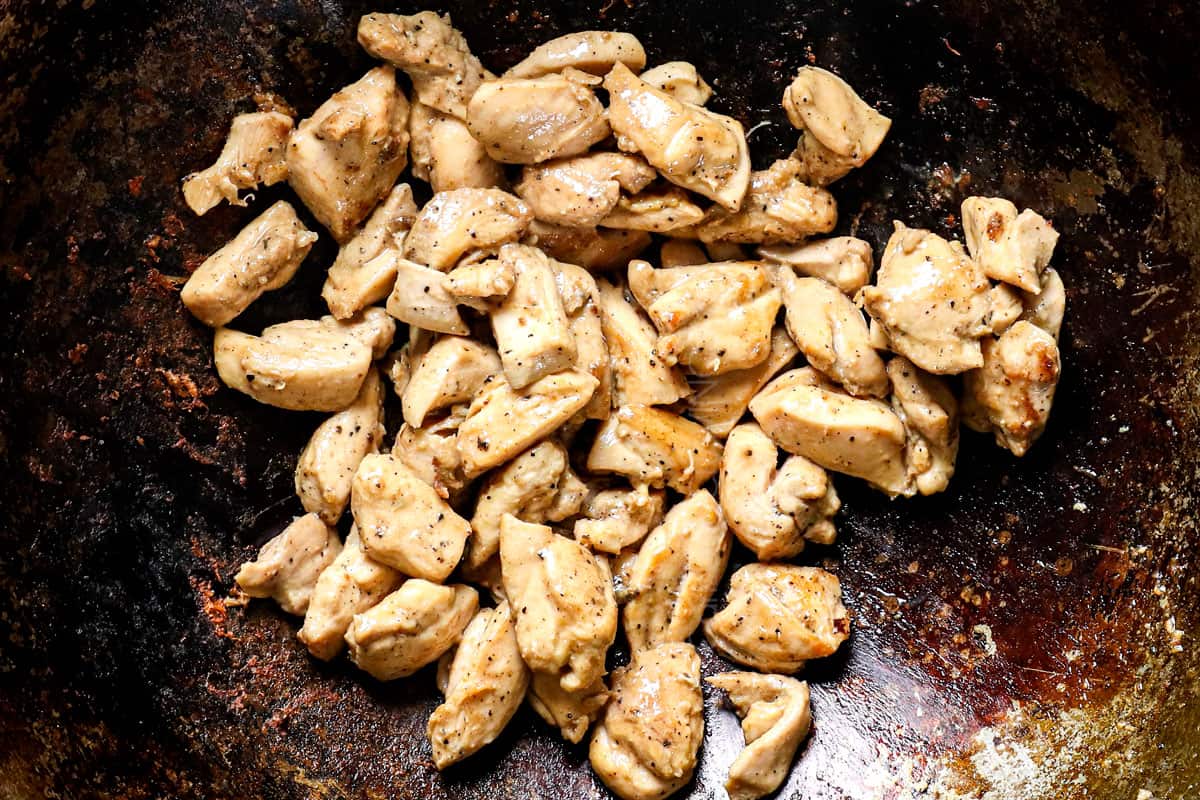
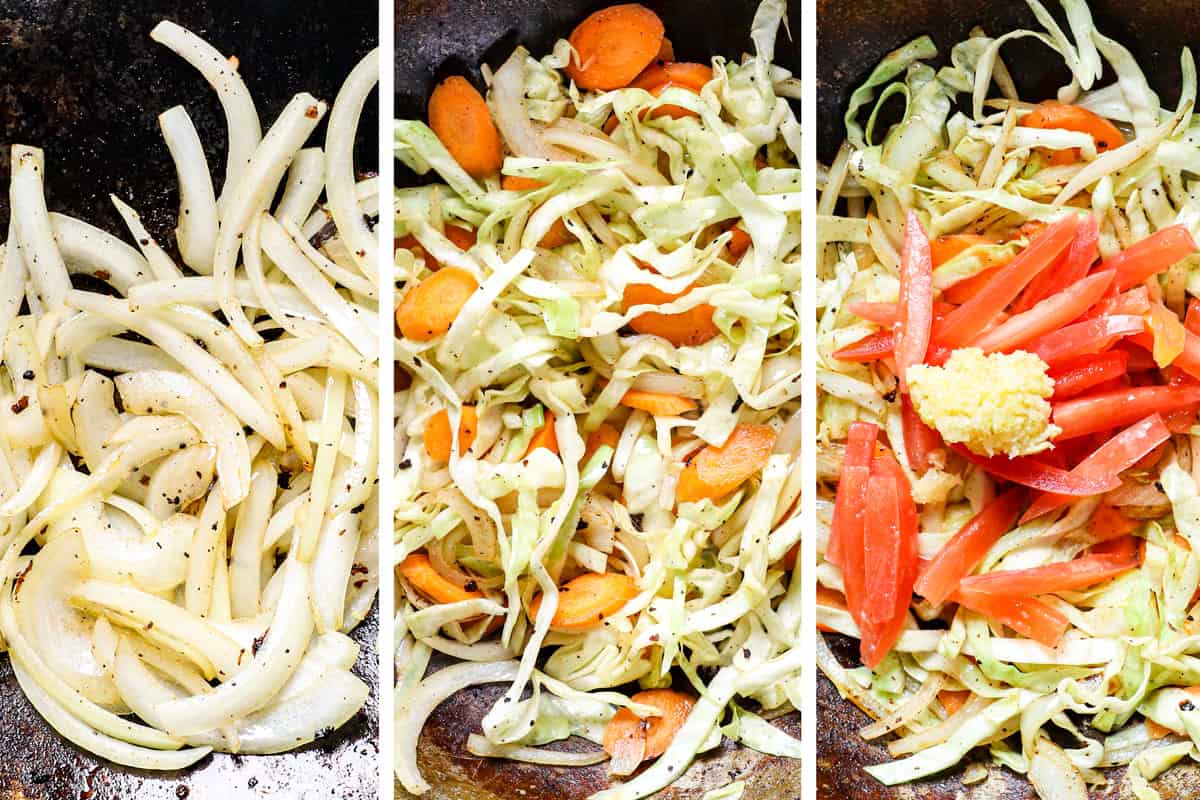

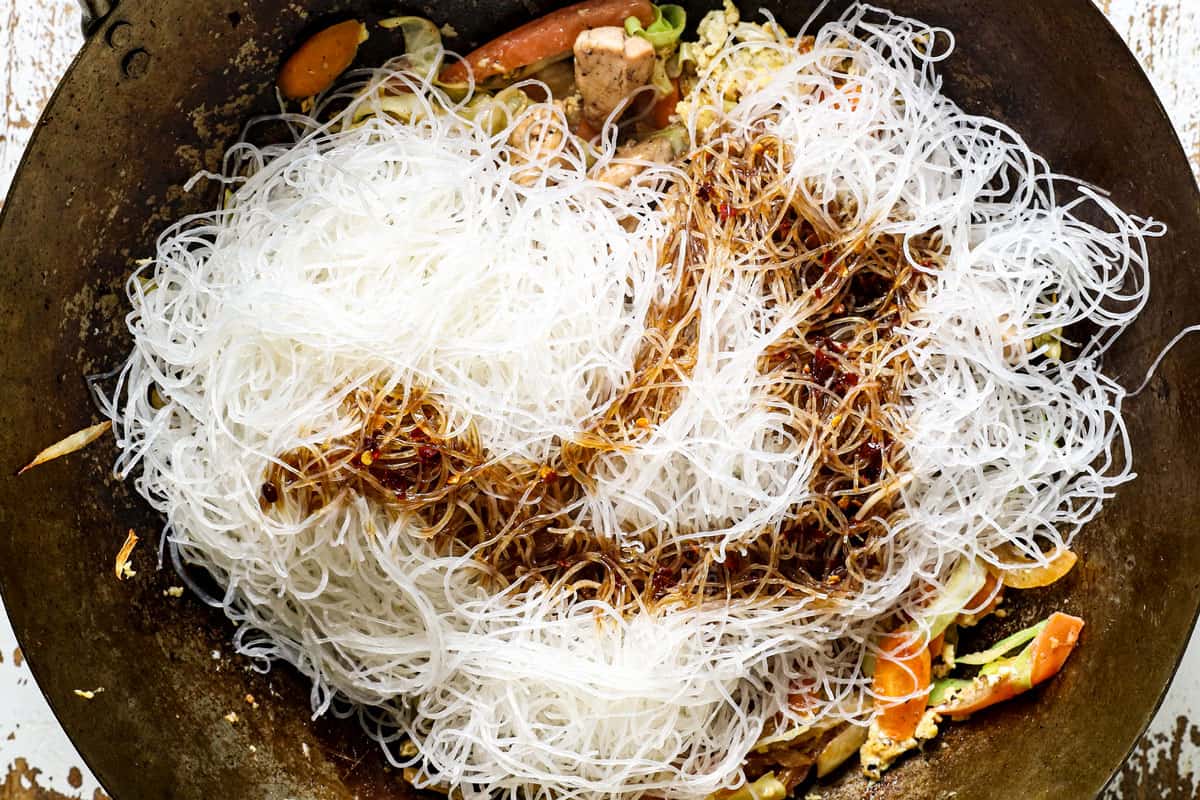
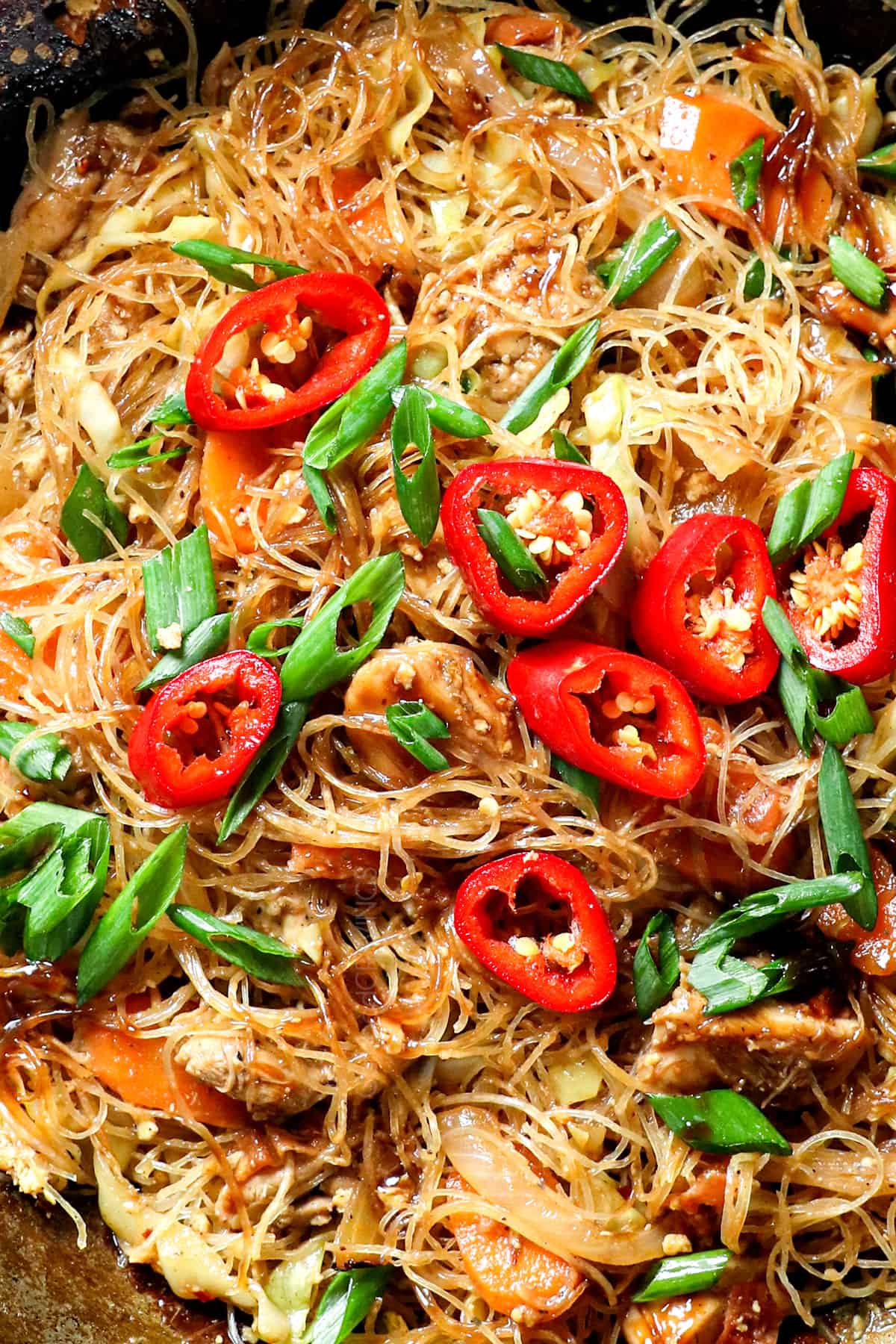
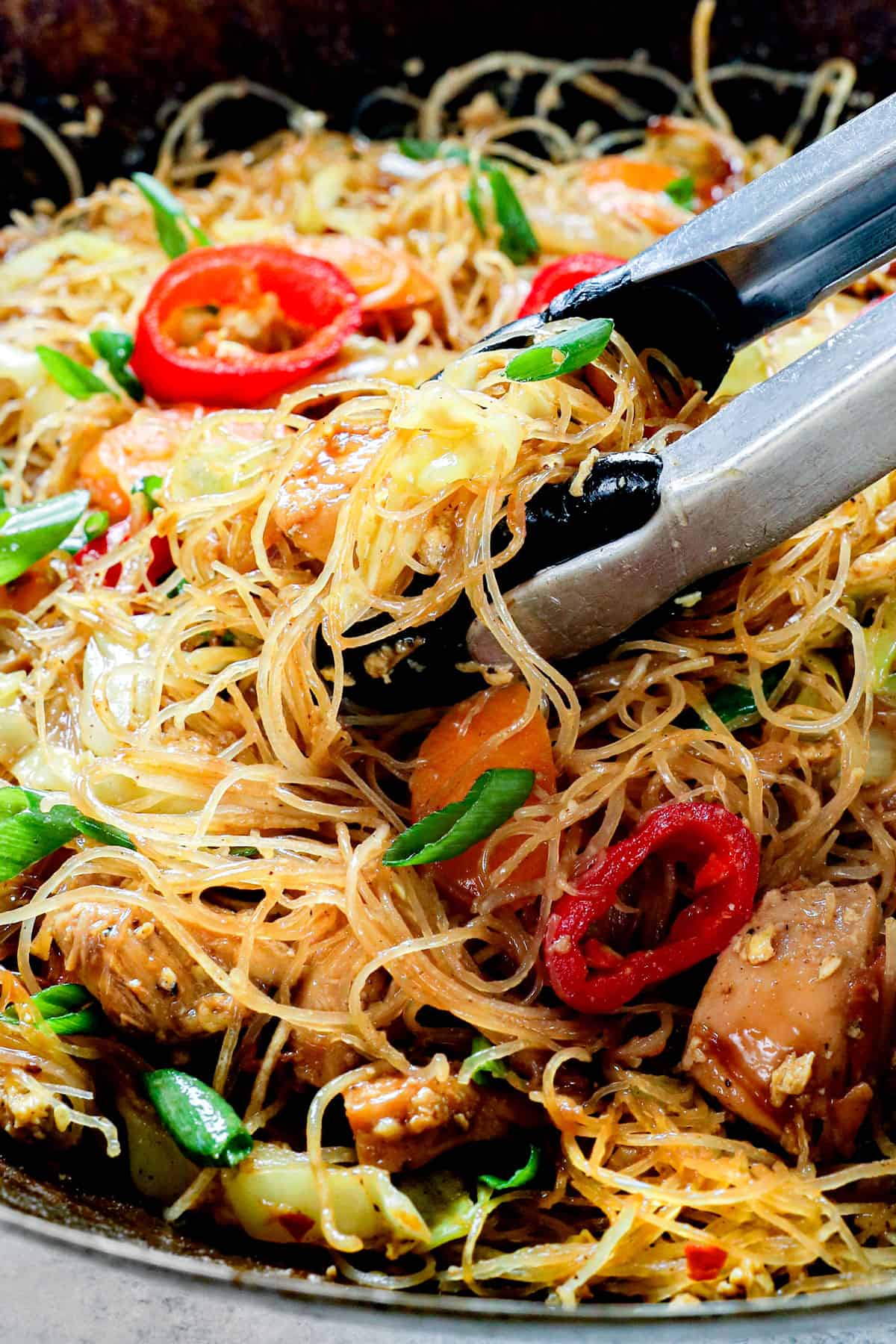

Thai Glass Noodles MEal Prep
You can prep all of the ingredients for this Pad Woon Sen recipe ahead of time so it can literally come together in minutes!
-Noodles: Soak the noodles, rinse and drain, then toss with a drizzle of toasted sesame oil. Store in an airtight container/plastic bag in the refrigerator for up to five days. Warm in the microwave for 10 seconds before using.
Chicken: Chop the chicken and store in an airtight container. The marinade can also be whisked together and stored separately from the chicken.
-Sauce: Whisk the sauce ingredients together and store it in an airtight container in the refrigerator. Let the sauce sit at room temperature while preparing the stir-fry; whisk again before using.
-Veggies: Chop the veggies and store in an airtight container in the refrigerator for up to 2 days.
-Cook: Within the next 48 hours, proceed to cook the glass noodle stir-fry as instructed.
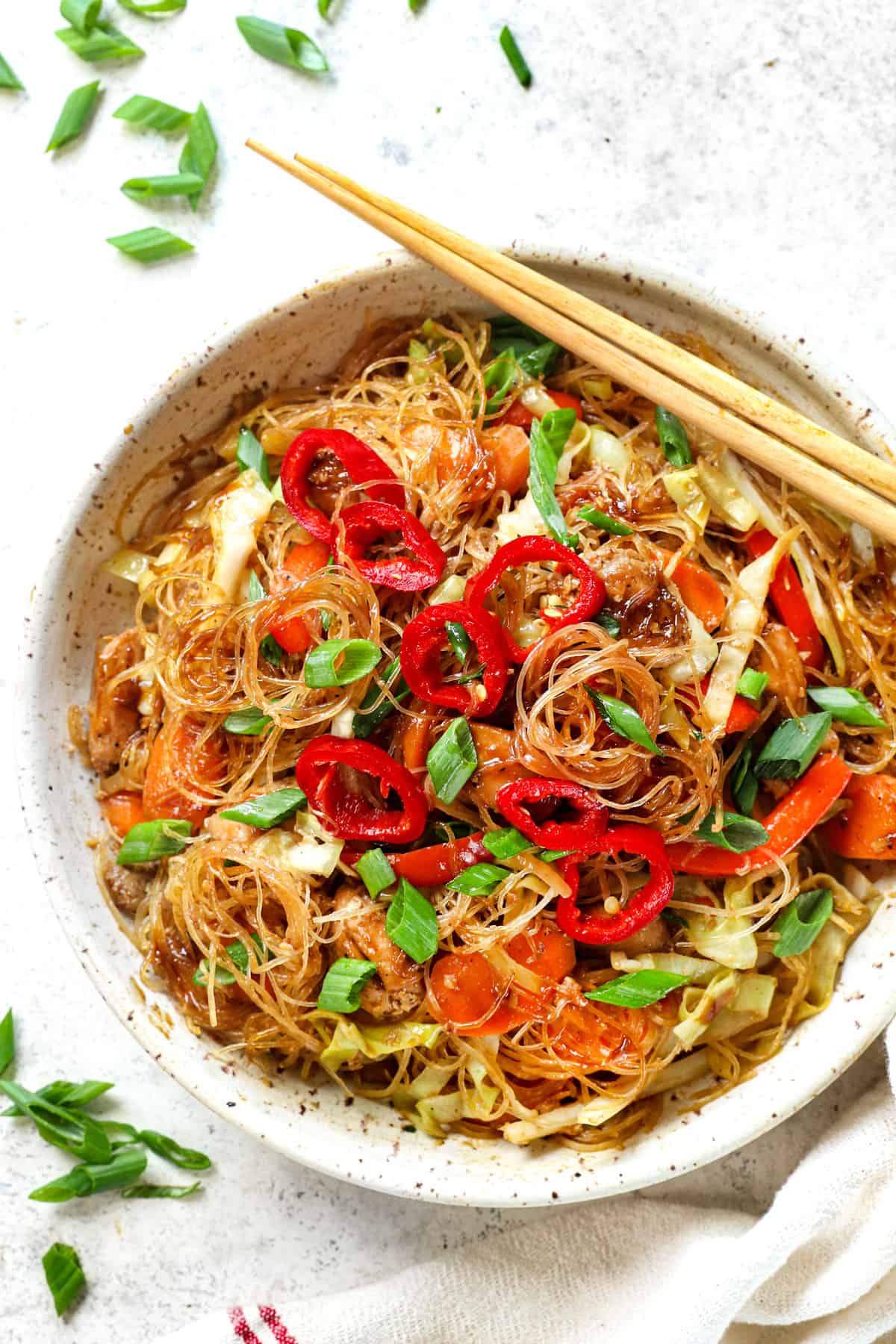
Pad Woon Sen FAQS
A wok is ideal to make this Thai Pad Woon Sen recipe because it can safely reach high temperatures to sear the ingredients without ruining the pan. If you don’t have a wok, you will want to use a large nonstick skillet, NOT stainless-steel or cast iron like commonly use in stir fries. The noodles are extremely sticky and will stick and break against any other pan that’s not nonstick unless you use an exorbitant amount of oil (which I don’t recommend!). Instead, a nonstick skillet can still deliver a successful, charred, caramelized stir fry by stirring the ingredients less and letting them nicely brown.
Thai Pad Woon Sen Noodles is an Asian “fusion food” favorite. It combines the technique of stir-frying noodles borrowed from Chinese immigrants with the taste of Thailand.
Thai noodles dishes such as Pad Woon Sen, Pad Kee Mao, Pad Thai and Pad See Ew became popular in World War II when Thailand was facing a rice shortage. Noodles, on the other hand, were in abundance so the Thai government encouraged the substitution of rice with these noodles. The citizens mixed noodles with various vegetables and proteins resulting in new inexpensive, instant classics that the world has been enjoying ever since.
Today, Pad Woon Sen is popular in Thailand sold by street vendors and in restaurants throughout the world.
Both Pad Woon Sen and Pad Thai are Thai noodle dishes, but they are quite different. Pad Thai is characterized by its nuttiness from crushed peanuts and a tangy, subtly sweet sauce made from tamarind sauce, fish sauce and palm sugar. It is made with wide rice noodles. Pad Woon Sen, on the other hand, is characterized by thin glass noodles and a slightly sweet-savory sauce. Pad Woon Sen is a more mild tasting dish.
Both Drunken Noodles and Pad Woon Sen are Thai noodle dishes made with protein, vegetables and similar sauces. Pad Woon Sen, however, is characterized by its use of glass noodles and slightly sweet sauce. Pad Kee Mao, on the other hand, is characterized by its wider rice noodles, spicy Thai chilies and fragrant, anise Thai holy basil which creates a fiery, fabulously fragrant sauce.
Both Pad Sew Ew and Pad Woon Sen are Thai noodle dishes made with protein, eggs and similar sauces. Pad See Ew, however, is made with wide rice noodles instead of glass noodles and only contains the vegetable Chinese broccoli. It is typically served with chili vinegar on the side. Pad Woon Sen, however, is made is made with glass noodles and a variety of vegetables.
Sweet potato noodles, used to cook Korean Japchae, are the best alternative to glass noodles. They have a similar chewy texture.

How do I reheat glass noodleS?
-Microwave: Transfer servings to a microwave-safe plate and splash with a touch of water to add some moisture back to the dish. Cook for 1 minute, stir, then continue to heat at 20-second intervals until warmed through.
-Stove: Reheat noodles gently over medium-low heat in a large skillet until warmed through, adding a splash of water or oil as needed.

HOW long are glass good for?
Thai glass noodles can be stored in an airtight container in the refrigerator for up to 5 days.
can I freeze thai noodles?
No, Pad Woon Sen should not be frozen. Glass noodles do not freeze well once combined with the sauce and will become an unpleasant texture when thawed.

Looking for more Thai Noodle Recipes?
Pad See Ew: made with wide rice noodles, crisp tender Chinese broccoli and soft eggs enveloped in a light, salty, savory sauce with a kiss of sweetness, a kiss of sour and a kiss of that irresistible charred smokiness.
Pad Thai: a popular classic with rave reviews made with chicken, veggies, and peanuts smothered in the most irresistible savory, sweet, salty, sour sauce.
Drunken Noodles: a popular, traditional Thai stir-fry made with wide rice noodles, fresh veggies (typically onions, bell peppers, baby corn and tomatoes) and your choice of protein.

WANT TO TRY THIS Pad Woon Sen RECIPE?
PIN IT to your Asian, Chicken or Dinner recipe BOARD TO SAVE FOR LATER!
FIND ME ON PINTEREST FOR MORE GREAT RECIPES! I AM ALWAYS PINNING :)!
©Carlsbad Cravings by CarlsbadCravings.com
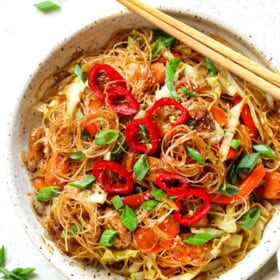
Pad Woon Sen
Save This Recipe To Your Recipe Box
You can now create an account on our site and save your favorite recipes all in one place!
Ingredients
Quick Chicken Marinade
- 1 pound chicken thighs cut into bite-size pieces
- 1 tablespoon reduced sodium soy sauce
- 1 teaspoon toasted sesame oil
- 1 teaspoon cornstarch
- ¼ teaspoon pepper
- 1 tablespoon peanut or vegetable oil for cooking
Glass Noodles
- 6 ounces dried glass noodles also known as mung bean, cellophane, bean thread noodles (see notes)
- 1 teaspoon toasted sesame oil
STIR FY
- 1 tablespoon peanut or vegetable oil
- 1/2 medium onion, thinly sliced
- 2 carrots, sliced
- 2 cups sliced cabbage
- 2 medium tomatoes, seeded, sliced into strips (not too thin)
- 1 red bell pepper, sliced
- 6 garlic cloves, minced
- 1 tablespoon minced ginger
- 2 eggs, whisked
Pad Woon Sen Sauce
- 3 tablespoons oyster sauce
- 3 tablespoons reduced sodium soy sauce
- 2 tablespoons dark brown sugar (may sub light)
- 1 tablespoon fish sauce
- 1 tablespoon rice vinegar
- 2 tablespoons water
- 1 teaspoon molasses (see notes)
- 1 teaspoon dried basil
- 1/2 tsp EACH ground coriander, ground white pepper (may sub black pepper)
- 1/2-1 teaspoon crushed red pepper flakes
FOR SERVING
- chopped green onions
- sliced chilies or chili sauce
Instructions
- Prepare chicken: Whisk together the Chicken Marinade ingredients in a medium bowl (soy sauce, sesame oil, cornstarch, pepper). Add chopped chicken and toss to evenly coat; set aside.
- Prepare the glass noodles: Soak the noodles in a bowl of hot water until tender, stirring occasionally so they don’t stick together, about 8-10 minutes. Drain and rinse the noodles in cold water. Toss with 1 teaspoon toasted sesame oil. Set aside.
- Make the sauce: Meanwhile, whisk the sauce ingredients together and prep the veggies, set aside.
- Stir fry the chicken: Heat 1 tablespoon oil in a wok over high heat or a nonstick skillet over medium-high heat. Add chicken and stir fry until cooked through, about 4-5 minutes; remove to palate.
- Stir fry the veggies: Heat another tablespoon of oil in the skillet. Add onions and stir fry for 3 minutes, until starting to caramelize. Add cabbage, carrots and bell pepper and stir-fry for about 1 minute. Add the tomatoes, ginger and garlic, and stir fry for 1 minute, until vegetables are almost to desired crisp-tenderness (they will cook a little more with the noodles).
- Cook the eggs: Push the vegetables to the perimeter of the pan. Add a drizzle of oil to the center of the pan. Add the beaten eggs to the hot oil and scramble in the center until cooked.
- Stir fry everything together: Add chicken back to the skillet, along with the noodles and sauce and toss to combine. Stir fry everything together until evenly coated in the sauce. Adjust to taste (I like additional white pepper).
- Serve: Garnish with green onions, chilies, and sesame seeds if desired.
Video
Notes
- Glass Noodles: These give the dish its quintessential chewiness. When shopping, look for bright white, very thin noodles with mung bean starch listed in the ingredients and not rice (which makes rice vermicelli noodles), and not sweet potatoes (which makes Korean glass noodles). If you can’t find glass noodles at your local Asian market, you can purchase them on Amazon HERE.
- Oyster/fish sauce substitute: If you’re allergic to shellfish/vegetarian, use Lee Kum Kee Vegetarian Stir-Fry Sauce instead of oyster sauce and fish sauce.
- Soy sauce + molasses + brown sugar: This trio creates an easy substitute for Thai sweet soy sauce. Do NOT skip the molasses, it is what makes this recipe taste authentic! Use low sodium soy sauce or your noodles will be too salty.

Did You Make This Recipe?
Tag @CarlsbadCravings and Use #CarlsbadCravngs
Leave a Review, I Always Love Hearing From You!



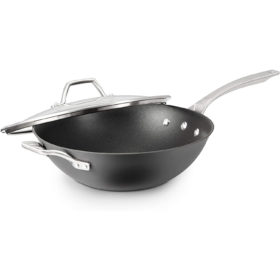


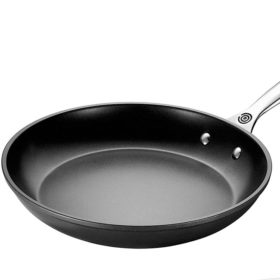
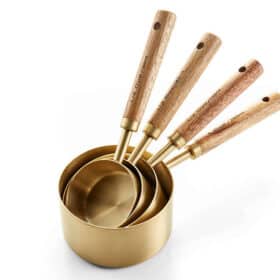
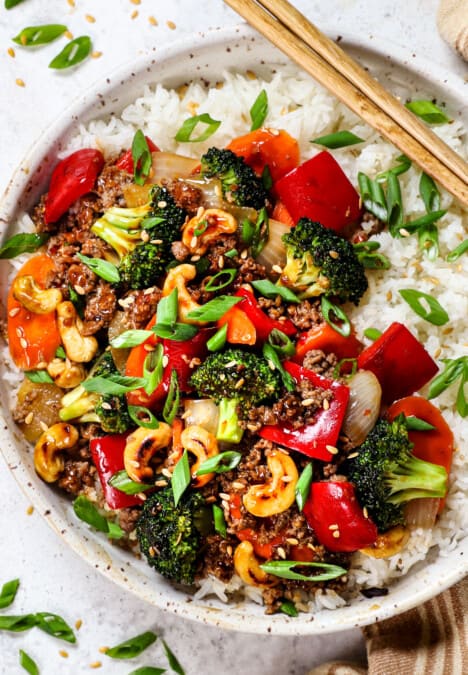
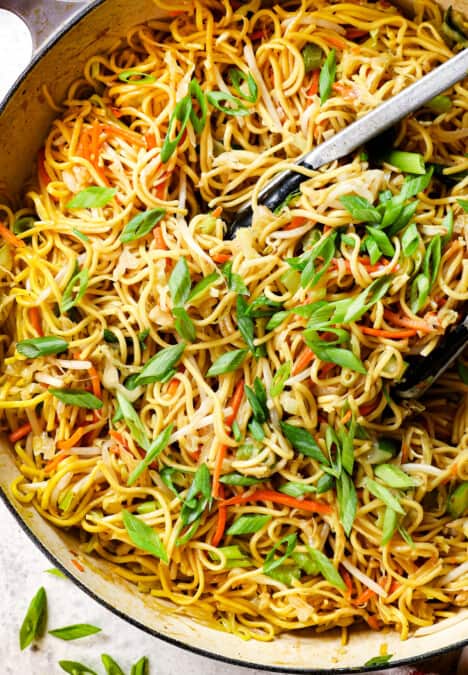
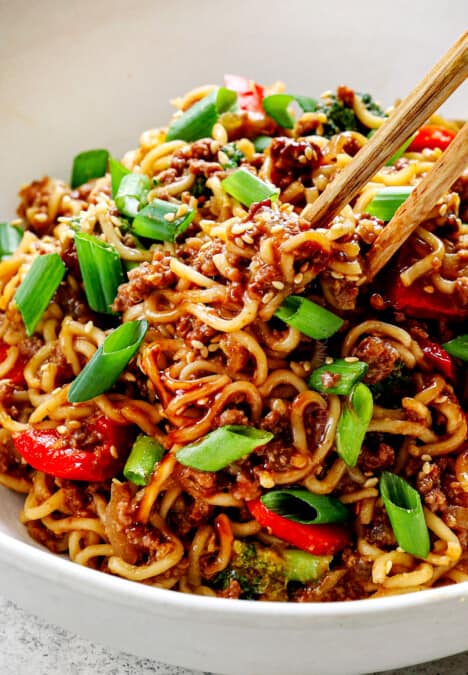

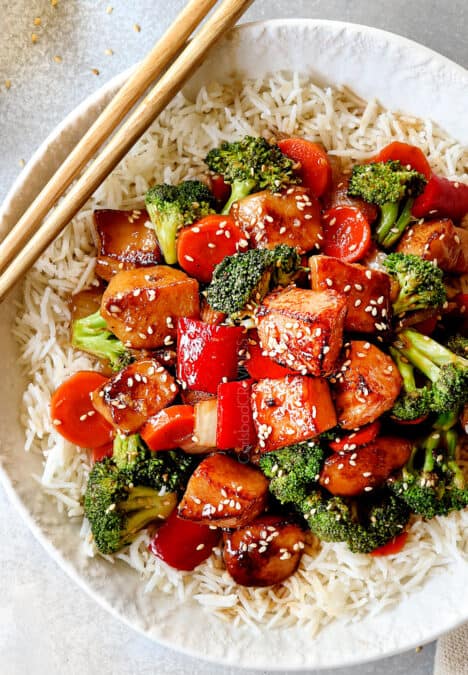
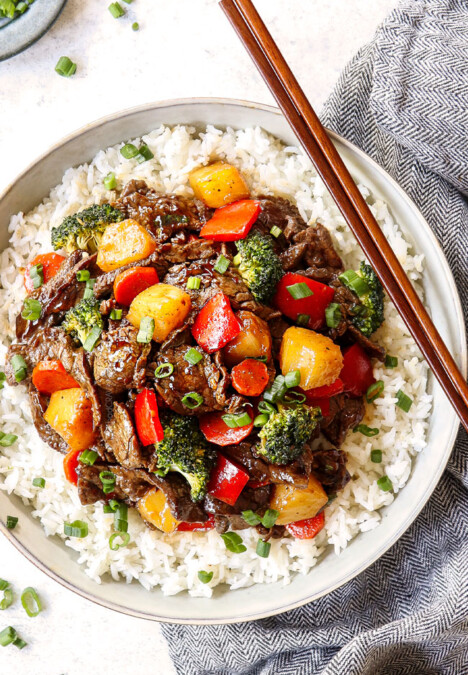























Marija Webers says
Made this with my daughter tonight, wr had so much fun…and this was fabulous!! We used chicken.
Jen says
What a fun way to spend time with your daughter! I’m soo pleased you enjoyed it Marija!
Mike Bartnett says
Hi Jen, is there a brand of low sodium soy sauce you prefer?
Jen says
I use Kikkoman from Costco, enjoy!
KLane says
Hi while this looks yummy it doesn’t seem authentic . I’ve never seen dried basil or ginger or even rice vinegar added. Is it a regional version? Just curious as I’ve eaten a lot of versions of this !
Jen says
This is my own version – it’s fabulous.
Erinn says
I never thought I’d make an Asian dish but wow this recipe was so YUMMY! I made a while ago and forgot to comment. This was a great hit at ladies lunch. (My good friends who don’t mind being my ‘guinea pigs’). This will for sure be made again.
Jen says
Thank you so much, Erinn! I am so happy you all enjoyed this and that it will be a repeat!
Megan says
Amazing flavor! Tastes exactly like the thai restaurant! Thank you for a great recipe!
Jen says
Thanks Megan! I’m so glad you enjoyed it!